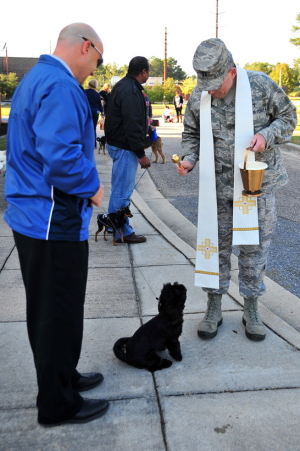FRIDAY, OCTOBER 4: Take your pet to a church service!
Many congregations nationwide are holding pet blessings in honor of St. Francis of Assisi, the patron saint of animals and the environment. What used to be a parade of rural farm animals down country lanes has evolved into preachers raising a hand over dogs, cats and hamsters; some pastors even travel to dog parks! But, note: Some blessings occur prior to the Oct. 4 feast day, while others are delayed until later in the calendar, so check your local listings.
Did you know? St. Francis of Assisi not only founded the Franciscan Order and the Order of St. Clare, but he also created the first Nativity scene—and received the first recorded stigmata!
Christians might not agree on the fate of pets, but St. Francis of Assisi went called animals his “brothers and sisters”; he insisted that they are an integral part of God’s creation.
ST FRANCIS: FROM WEALTH TO INTENTIONAL POVERTY
As with many famous saints, St. Francis’ life began in wealth. Born to a cloth merchant in Assisi in 1181, Francis lived in luxury until war called him away from home, in 1204. It was immediately following the war that Francis received a vision; he soon lost his desire for a worldly life and returned to Assisi as a peasant. Francis’ father disowned him for his choice to follow Christ, and the saint-to-be began both begging and preaching on the streets. Soon after, Francis created an order that would, in 10 years, number more than 5,000. St. Francis was canonized less than two years after his death.
ST. FRANCIS: ON ANIMALS, NATURE & THE ENVIRONMENT

U.S. Air Force Chaplain (Capt.) Jesus Navarrete sprinkles a dog with holy water during the Blessing of Pets ceremony at Seymour Johnson Air Force Base. Photo by Senior Airman Aubrey White, courtesy of U.S. Air Force
St. Francis wasn’t the first to raise the question of animals in heaven—and he wasn’t the first to affirm his belief, either! (It’s a common theme in Psalms that all creatures of God, whether man or beast, have a duty to praise Him.) Nor was St. Francis the last to preach this message: although some evangelical Christians believe that our pets are barred from heaven, the founder of Methodism, John Wesley, was famous as an early advocate for humane treatment of animals. Wesley preached that we will see our pets in heaven. To this day, many Protestant and Anglican congregations offer St. Francis-themed blessings of animals.
St. Francis challenged everyone to protect nature: We are, after all, God’s stewards on earth. Legends about St. Francis paint a portrait of a man whose donkey wept upon his death; who blessed a wolf and commanded him to stop harming townspeople and their flocks; and who garnered rapt attention from birds when he told his companions that he would “preach to” his “sisters the birds.” It’s said that during his sermon, not one bird flew away.
AT HOME: ST. FRANCIS FOR FAMILIES
Whether you’re honoring St. Francis or your own pet today, there are plenty of activities to choose from! Those wishing to remember the saint can pray the Canticle of the Sun; learn more about the fantastic festival in Assisi today; or cook up an Italian feast. (Catholic Culture has additional ideas.) Aside from taking your pet for a walk or to a pet-blessing service, animal lovers can raise money for a local animal shelter; make Fido an herbal flea collar; or even take a lesson in pet communication. (TLC has more.)
